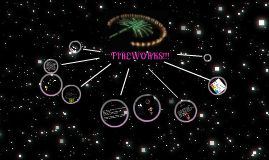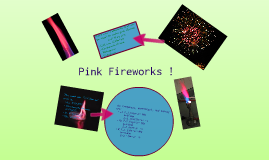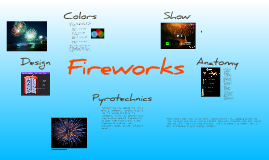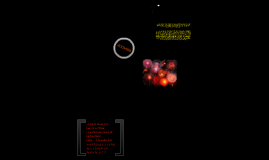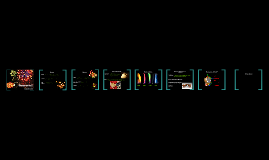Fireworks
Transcript: Fireworks Pyrotechnics are simply the art of making fireworks. Pyrotechnicians are the people who make the fireworks. Stars are pyrotechnics. They include several ingredients to give them their shine. these ingredients include fuel, oxidizer, color, binder, chlorine donor. Their colors come from the different temperatures of hot, glowing metals and from the light emitted by burning chemical compounds. Chemical reactions propel them and burst them into special shapes. Here's an element-by-element look at what is involved in your average firework: • Aluminum - Aluminum is used to produce silver and white flames and sparks. It is a common component of sparklers • Antimony - Antimony is used to create firework glitter effects. • Barium - Barium is used to create green colors in fireworks, and it can also help stabilize other volatile elements. •Calcium - Calcium is used to deepen firework colors. Calcium salts produce orange fireworks. • Carbon - Carbon is one of the main components of black powder, which is used as a propellant in fireworks. Carbon provides the fuel for a firework. Common forms include carbon black, sugar, or starch. • Iron - Iron is used to produce sparks. The heat of the metal determines the color of the sparks. • Lithium - Lithium is a metal that is used to impart a red color to fireworks. Lithium carbonate, in particular, is a common colorant • Magnesium - Magnesium burns a very bright white, so it is used to add white sparks or improve the overall brilliance of a firework. • Oxygen - Fireworks include oxidizers, which are substances that produce oxygen in order for burning to occur. The oxidizers are usually nitrates, chlorates, or per chlorates. Sometimes the same substance is used to provide oxygen and color. •Phosphorus - Phosphorus burns spontaneously in air and is also responsible for some glow-in-the-dark effects. It may be a component of a firework's fuel. • Potassium - Potassium helps to oxidize firework mixtures. Potassium nitrate, potassium chlorate, and potassium per chlorate are all important oxidizers • Sodium - Sodium imparts gold or yellow colour to fireworks, however, the colour may be so bright that it masks less intense colours • Sulfur - Sulfur is a component of black powder. It is found in a firework's propellant/fuel. • Strontium - Strontium salts impart a red color to fireworks. Strontium compounds are also important for stabilizing fireworks mixtures. • Titanium - Titanium metal can be burned as powder or flakes to produce silver sparks. • Zinc - Zinc is used to create smoke effects for fireworks and other pyrotechnic devices. (Helmenstine,2012) Firework Colorants Color Compound Red strontium salts, lithium salts lithium carbonate, Li2CO3 = red strontium carbonate, SrCO3 = bright red Orange calcium salts calcium chloride, CaCl2 calcium sulfate, CaSO4•xH2O, where x = 0,2,3,5 Gold incandescence of iron (with carbon), charcoal, or lampblack Yellow sodium compounds sodium nitrate, NaNO3 cryolite, Na3AlF6 Electric White white-hot metal, such as magnesium or aluminum barium oxide, BaO Green barium compounds + chlorine producer barium chloride, BaCl+ = bright green Blue copper compounds + chlorine producer copper acetoarsenite (Paris Green), Cu3As2O3Cu(C2H3O2)2 = blue copper (I) chloride, CuCl = turquoise blue Purple mixture of strontium (red) and copper (blue) compounds Silver burning aluminum, titanium, or magnesium powder or flakes Some safety tips • Never allow children to play with or ignite fireworks. Read and follow all warnings and instructions.( Witmer,2010) • Be sure other people are out of range before lighting fireworks. • Only light fireworks on a smooth, flat surface away from the house, dry leaves, and flammable materials. • Never try to relight fireworks that have not fully functioned. • Keep a bucket of water in case of a malfunction or fire.( Witmer,2010) Colors are produced by putting different chemicals into the firework. Blue is created with coppers. Red is created with strontium. Yellow is created with Sulfur. Green is created with barium. You can also create colors by mixing two of these colors. For example you could create purple by mixing strontium and copper. Design Time Delay Fuse Main Fuse Launch tubes in firworks are made of steel and have the same diameter of the firework itself but are three times as long! Stars are what make the show happen. When they are in the firework they just look like a little round sphere. When they are ignited they Create the light and color of the firework. The time delay fuse makes it so you can have more than one explosion in one firework. The timing has to be exact or it won't work. Break A break is like a compartment. It is where the stars are held and where the magic happens. They are made of cardboard and are used to spread out the display. Show Black powder Colors When the black powder confined in the bottom of the firework heats, it pushes at the launch tube until it explodes. Black powder is used in






